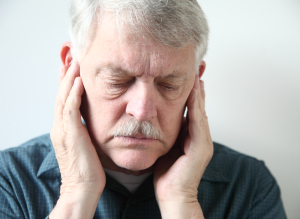A TMJ problem is medically termed temporomandibular disorder or TMJ disorder. The temporomandibular joint (TMJ) is a joint between the jaw and the temporal bone of the skull. As this image shows the mandibular condyle does not articulate directly with the glenoid fossa of the temporal bone, but there is a donut like disc or meniscus in between, which separates the TMJ into an upper and lower joint component.
Several conditions can cause jaw pain (TMJ pain) such as osteoarthritis, rheumatoid arthritis, infectious arthritis and several other medical conditions. Usually TMJ pain or dysfunction is associated with pain centered around the TM joint and in the teeth. But this image shows that it tends to radiate into the adjacent areas of the head and neck. It tends to be multifactorial. There are dentists who specialize in this very complicated field. The patient would be advised to see one of these specialists, if the dentist has no readily available answers. A myofascial pain syndrome can develop out of TMJ dysfunction, if it is not treated.
Symptoms
There is tenderness just below the external ear canal on the affected side. In pronounced cases the jaw may move to the affected side when the mouth is opened. There may be clicking and sometimes catching in the affected jaw joint. The patient may get muscle spasm in the night from nocturnal bruxism. Myofascial pain syndrome can occur in patients with normal temporomandibular joints. This syndrome is more common in women that in men and has a peak in women ion their early 20s and again around the time of menopause.
More info: Temporomandibular joint pain (thanks to www.ncbi.nlm.nih.gov/books for this link)
References:
1. Suzanne Somers: “Breakthrough” Eight Steps to Wellness – Life-altering Secrets from Today’s Cutting-edge Doctors”, Crown Publishers, 2008
2. http://www.webmd.com/oral-health/dental-root-canals
3. http://www.aacd.com/whitening
4. http://www.nhs.uk/conditions/Gum-disease/Pages/Introduction.aspx
5. http://www.aae.org/patients/treatments-and-procedures/root-canals/root-canals.aspx
6. http://en.wikipedia.org/wiki/Dental_trauma
7. http://www.dailymail.co.uk/health/article-25286/The-complete-guide-cosmetic-dentistry.html







